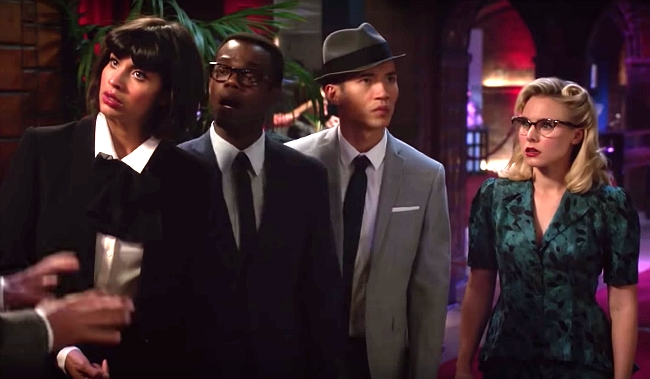
The Good Place is a show that only works when it adheres to a strict set of rules. It’s a comedy built around a heady concept that could have a companion course taught in college alongside its episodes. But the weighty issues of morality and good and evil are often made accessible to the viewer though downright silly things.
Jeremy Bearimy is a good example of that, as the concept of linear time on Earth in relation to how time passes elsewhere was essentially explained away with two words written in cursive. After nearly three seasons of an ever-shifting concept of reality and time on The Good Place, viewers finally got an explanation for one of the biggest questions lingering about how it all works. It was super dumb, it broke Chidi and maybe a lot of people at home, but it was also hilarious.
If graphic organizers about linear time doesn’t sound very funny, well, yeah on paper a show about torturing humans for the bad things they did on Earth doesn’t sound all that funny. It’s kind of a show about philosophy and often doubles as a thought experiment simulator. But the fact that it’s one of the funniest and most thoughtful shows on TV speaks to the importance of those rules.
And one of those rules is just how the Bad Place is portrayed on the show. It is hell, after all, which means that 1) it has a gift shop and 2) some pretty terrible things are happening to people who were less than good during their life. The Good Place creator Mike Schur said the writers on the show have some specific rules about what they can and cannot show in the Bad Place, though, and what kinds of torture they want viewers thinking about. According to Vulture, kids are off-limits.
“No kids, because that’s too depressing, and no physical anguish,” Schur told Vulture. “I think that keeps the show from devolving into some weird manifestation about human pain. It’s better to show toxic masculinity or annoying YouTubers, because that sounds like what hell really is.”
It’s a shrewd way to illustrate a very bleak topic, but it’s a common thread that’s ran throughout a show that’s changed dramatically in its three seasons. Think about the sublime beauty of the four main characters’ original torture. The Bad Place disguised as the Good Place allowed for the minor slights and emotional anguish that feel like torture in the moment. Chidi got chased by bees once, sure, but his own indecision was torture all its own. Michael, the architect of all this torture, really had built something amazing before Eleanor and Co. messed it all up.
The demons can speak about terrible things looming for the guy who created Girls Gone Wild and sometimes they’ll spring for some CGI to show lava monsters in their true form, but most of the graphic torture on The Good Place is all told, not shown. And the writers are very careful to make sure you know the people ushered into the Bad Place truly deserve what’s coming to them. Usually for doing something that’s equally as funny and awful as the torture they endure in the afterlife.
“If they were really evil demons who were hedonistically ripping people’s eyes off and stuff, that doesn’t sound too funny,” Schur said. “There’s an episode where Dax Shepard guest stars and there’s a group of dudes who work in the toxic masculinity department. For me, if there’s a hell and I go there, it would be those dudes greeting me.”
The joke is that the people who are in the Bad Place are actually terrible, as are the demons who are in charge of making sure they suffer forever for being terrible in the first place. But even hell has its limits on network television, and they’ve done a good job of not going for cheap violence and traditional concepts of eternal damnation.
Still, the strength of the show is that, despite their faults, the main characters of the show actually exist somewhere in between. Eleanor is very much a work in progress, and Michael is literally a demon straying from the dark lord of bureaucratic torture’s warm glow. An all-knowing being is trying to figure out how to love, and now how to exist and not actually know everything anymore. Time and time again The Good Place has shown that anyone given even a bit of critical examination is somewhere between truly good or bad. But the root of the show, and what holds it all together in the first place, are the strict rules that create those absolutes. The fun parts of the show, however, are usually all the exceptions to those rules.
(via Vulture)






